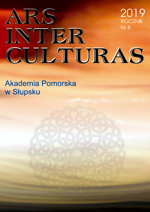ОПЕРЫ ГЕНДЕЛЯ В КОНТЕКСТЕ СОВРЕМЕННОЙ РЕЖИССУРЫ: К ВОПРОСУ О ПРЕТВОРЕНИИ ПРИЁМОВ СОВРЕМЕННЫХ МЕДИА
HANDEL’S OPERAS IN THE CONTEXT OF CONTEMPORARY DIRECTING: ON THE IMPLEMENTATION OF MODERN MEDIA TECHNIQUES
Author(s): Gregory Konson, Irina KonsonSubject(s): History, Philosophy, Social Sciences, Fine Arts / Performing Arts
Published by: Wydawnictwo Naukowe Akademii Pomorskiej w Słupsku
Keywords: Handel; Halle; city; theater; Opera; Director; hero; composer; performer; author; ballet; stage; Aria; entering into the image; building sense; layers of consciousness; screen
Summary/Abstract: The article is based on the interaction of two genres, namely travel notes, including the author’s impressions of a trip to the German cities of Halle, Bad-Lauchstedt and Bernburg, as well as reviews of modern productions of Baroque operas. Halle is famous as the birth- place of the outstanding composer Georg Friedrich Handel (1685-1759). The international Handel music festival is held here every year, which also includes an international scien- tific Symposium dedicated to the study of the great Saxon and his contemporaries. The concept of this year’s Symposium, “Sensitive, heroic, sublime: Handel’s women”, was to study the female images embodied in his operas. The authors traveled to Halle as journal- ists to describe their impressions of both the trip and the contemporary productions of Handel’s stage works. But in considering the history and cultural events of this city, we were able to go beyond ordinary observations into the sphere of scientific generalizations and come to the conclusion that the directors’ understanding of these operas through the in- tegration of musical drama with related arts was unusually expanded. To study this phe- nomenon, we turned to the scientific tools developed in Russia by two Soviet researchers who have become seminal in their field. One of them was the psychologist Lev Vygotsky, who, exploring the spiritual world of the hero in fiction, revealed his psychological contra- dictions, expressed in the conflict of the narrative and the plot. The other, Sergei Eisenstein, who knew Vygotsky’s manuscript of his study “Psycholo- gy of Art” and, with some influence from these ideas, created his own “psychology of art”, which is set out in the pages of his works of different years. The core of this concept was “the transition from the Expressive Movement to the image of a work of art... as a process of the interaction of layers of consciousness”29, which allowed for multiple entries into the artistic image. Such entries are also supported by some features of the cinematograph where the first among equals is the principle of intellectual editing, based on Eisenstein’s montage theory. In Eisenstein’s theory, other types of editing – linear, parallel, associative – have been generalized and developed into a large-scale system of the psychology of he- roes in art. In this article, the identification of the essence of these processes made it possi- ble for the authors to discern the phenomenon of increasing the meaning in the Halle direc- tors’ interpretations of Handel’s operas, which arises from the merger of two seemingly irreconcilable and conflicting layers of consciousness: Baroque and eclectic modern, which developed at the turn of the last century.
Journal: Ars Inter Culturas
- Issue Year: 2019
- Issue No: 8
- Page Range: 259-278
- Page Count: 20
- Language: Russian

